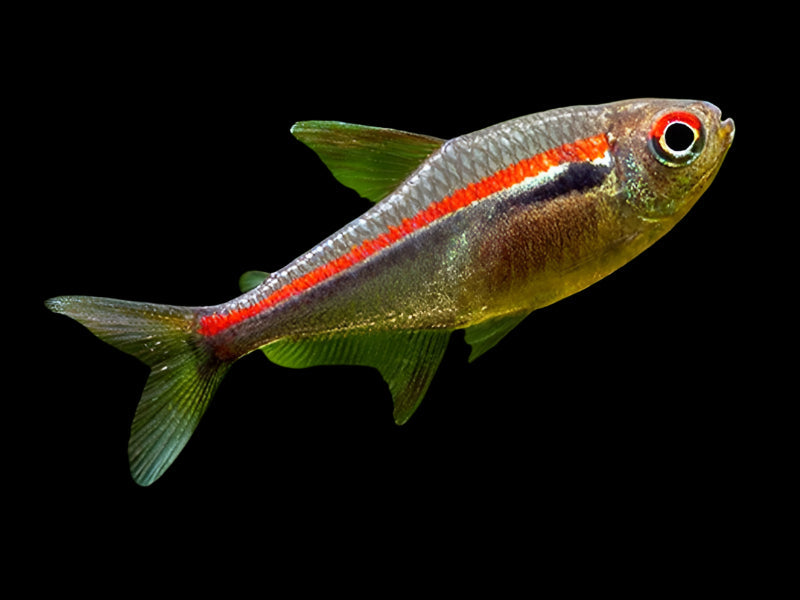Description
Amapá Tetra – A Luminous Jewel of the Amazon
Bring a unique splash of color and elegance to your aquarium with the Amapá Tetra, a captivating species that’s perfect for both beginner and experienced aquarists alike. Native to the Amapá region of the Amazon River basin in Brazil, this stunning tetra is known for its shimmering body, which glows with an iridescent blue-green hue, accentuated by a delicate silver sheen that makes it a true aquarium gem.
A peaceful and social species, the Amapá Tetra thrives in schools, where its iridescent beauty and graceful movements truly shine. With its calm demeanor and small size, it is an ideal addition to community tanks and works well with other non-aggressive species.
Key Features & Care Guidelines:
-
Stunning Coloration: Beautiful, iridescent blue-green body with a shimmering silver sheen that catches the light from every angle.
-
Behavior: Peaceful and social schooling fish; best kept in groups of 6 or more for natural social behavior and reduced stress.
-
Tank Size: Minimum 15 gallons recommended to provide enough space for swimming and social interaction.
-
Water Parameters: Prefers soft, slightly acidic water with pH between 6.0 and 7.0, and temperatures from 74°F to 80°F (23°C to 27°C).
-
Diet: Omnivorous; enjoys a varied diet of flakes, micro pellets, and occasional live or frozen foods like brine shrimp or daphnia.
-
Tank Setup: Ideal for well-planted tanks with plenty of open swimming space and some shaded areas for hiding.
-
Experience Level: Hardy and relatively easy to care for, suitable for beginners as well as more experienced aquarists.
Add the Amapá Tetra to your aquarium for a glowing, peaceful presence that will bring beauty and activity to your tank, as well as a touch of South American elegance.
Click & Collect
Livestock will only be bagged once you arrive, or if you contact us in advance to request it ready beforehand.
Local Delivery
Order anything from our in-store range and have it delivered right to you.
-
Minimum spend: £50
-
Delivery up to 10 miles: £10
-
Delivery up to 25 miles: £20
Distances are measured “as the crow flies”, not by road.
Once your order is placed, we’ll be in touch to arrange a suitable delivery date and time.
Please note, delivery may take a little longer as we often group orders together to build an efficient delivery run.
Important: If you’re ordering a large aquarium, please ensure someone is available to help unload the van on arrival.
Dry Goods Delivery
-
DX Express: 1 working day, same-day dispatch before noon 0-75kg
-
Express Pallet: 1–3 working days 75-500kg
If you'd like to add more items to an existing order that hasn't yet been dispatched, please place a Click & Collect order and leave a note asking us to combine the orders.
Please note: We currently only dispatch parcels Wednesday to Friday.
Pre-Order
Want the full details? Check out our Terms & Conditions.
Livestock Delivery
Thursday Delivery – £24
-
Dispatched Wednesday afternoon
-
Delivered Thursday before 1pm
-
Order by Wednesday 12 noon
-
Minimum spend: £50
Friday Delivery – £24
-
Dispatched Thursday afternoon
-
Delivered Friday before 1pm
-
Order by Thursday 12 noon
-
Minimum spend: £50
Saturday Delivery – £29
-
Dispatched Friday afternoon
-
Delivered Saturday before 1pm
-
Order by Friday 12 noon
-
Minimum spend: £50
📦 Want to Add to an Existing Order?
No problem! Just place a Click & Collect order and leave a note asking us to link it with your original one (as long as it hasn’t been dispatched yet).
🛒 Dry Goods Now Included!
You can now include dry goods in your livestock delivery – perfect for topping up supplies in one go.
❄️ Please note: We can’t send frozen food with livestock – please order frozen items separately.
⚠️ Delivery Exclusions
Unfortunately, we’re unable to deliver livestock to the following postcodes:
Scotland & Isles:
AB30–AB56, DD8–DD10, DG3–DG9, DG12–DG14, FK17–FK21, KA18–KA19, KA26–KA30, PA20–PA38, PA80, PH3–PH40
Cornwall Isles: TR21–TR25
All of the following postcodes are excluded:
BT, HS, IM, IV, JE, KW
Plus Channel Islands and Shetland Islands
Payment & Security
Your payment information is processed securely. We do not store credit card details nor have access to your credit card information.


